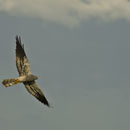Biology
(
Inglês
)
fornecido por Arkive
Breeding pairs are formed when the birds reach about 2-3 years of age, these bonds may be life-long, but polygyny may occur. This species performs elaborate courtship rituals, similar to those of the marsh harrier. The pair circle together at great heights, may pass food to each other, and roll or tumble together, often with talons outstretched. Egg-laying occurs between May and June. The female constructs nests on the ground from grass and sticks. 4 or 5 eggs are laid, and incubation takes about 40 days. After a further 42 days or so the young birds fledge (2). Hunting behaviour is similar to that of the Marsh harrier, and involves slow back and forth flight close to the ground. When prey is located the bird suddenly drops onto the quarry, with talons outstretched. Prey species include small mammals and ground birds, reptiles and invertebrates (2).
Conservation
(
Inglês
)
fornecido por Arkive
No recent nesting site has been located within a protected area or Site of Special Scientific Interest (SSSI), however much of the former nesting grounds are now afforded protection. Nests on arable land must be located so that damage by farming practices can be avoided. Research is being carried out on the breeding biology, population dynamics and food of the species (3).
Description
(
Inglês
)
fornecido por Arkive
Named after the early nineteenth century ornithologist Col. George Montagu, the Montagu's harrier is the smallest of Britain's 3 harrier species, and is superficially similar to the hen harrier, (Circus cyaneus). Females are brown with a whitish rump, juveniles are similar in colour to females but have reddish-brown underparts. Males are pale grey with black wing bars and wing tips, and have a grey rump. This species is generally silent, but can be heard producing a high-pitched 'yik-yik-yik' call in the breeding season (2).
Habitat
(
Inglês
)
fornecido por Arkive
In Britain nesting traditionally occurred in reed beds, rough grassland, young conifer plantations, and on heathland and moorland. More recently however, most nests have been made in cereal fields (3).
Range
(
Inglês
)
fornecido por Arkive
Montagu's harrier is a rare summer visitor to southern Britain. They breed across southern and central Europe and Asia, and over-winter in Africa and India. Most of the 5,500-6,000 strong European population is concentrated in Spain, France and Portugal (3).
Status
(
Inglês
)
fornecido por Arkive
Listed on the Amber List of Birds of Conservation Concern, Annex 1 of the EC Birds Directive, and Appendix II of the Bern Convention. Protected under Schedule 1 of the Wildlife and Countryside Act 1981 in the UK (3).
Threats
(
Inglês
)
fornecido por Arkive
The species was heavily persecuted in Britain during the 19th and early 20th centuries, and between 1850 and1920 no more than 7 pairs were recorded in any one year. The population then increased to 30 nests in 1953. The species was widely distributed at this time, with main population clusters in East Anglia and the South West. A further decline down to just 7 breeding pairs occurred between 1953 and 1962; this is thought to have been due to the widespread use of organochloride pesticides such as DDT at this time, which thinned eggshells and accumulated in the tissues of adult birds. No pairs at all were recorded between 1974 and 1975. Since then the population has fluctuated between two and eight breeding females. Montagu's harriers breed later in the season than marsh harriers, and as they nest amongst cereal crops, current threats to nests and young include toxic sprays and harvesting machinery. Predation by foxes may also cause losses, as does disturbance by birdwatchers, who are attracted by this beautiful bird's rarity (3).

